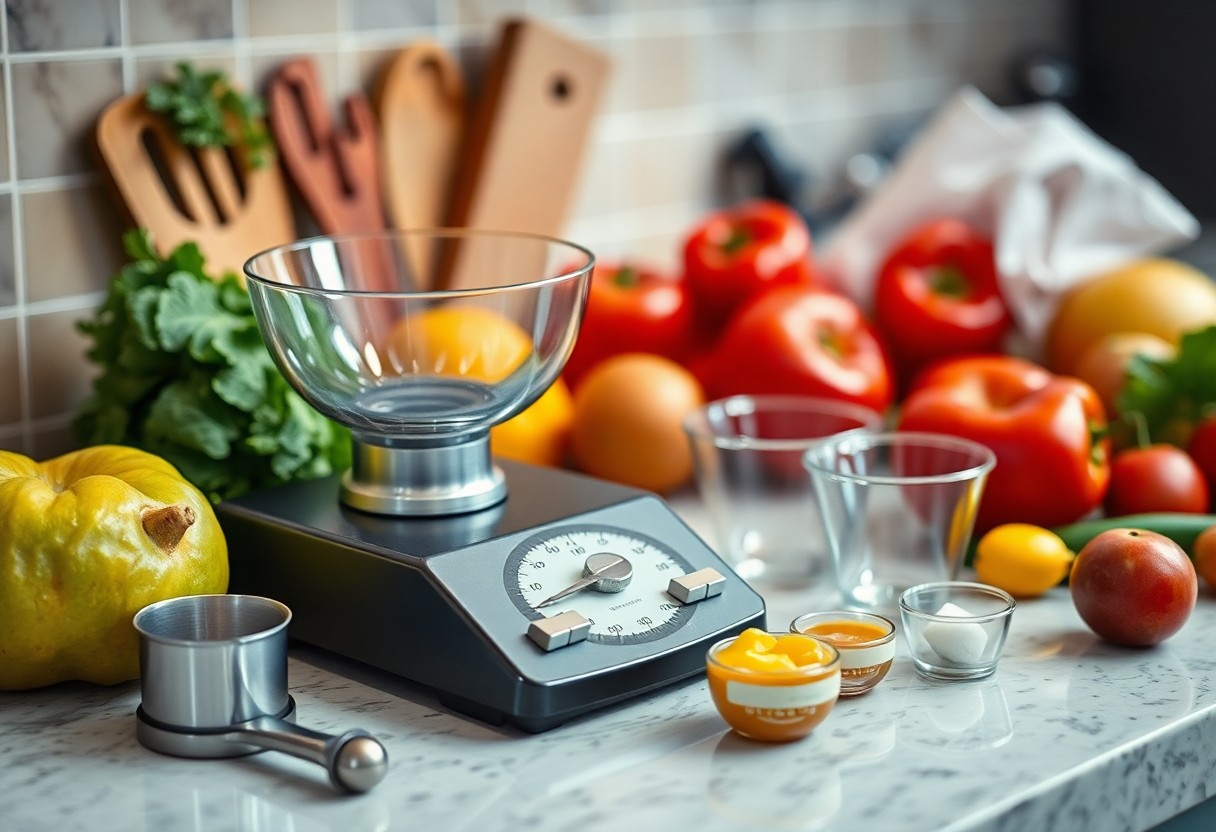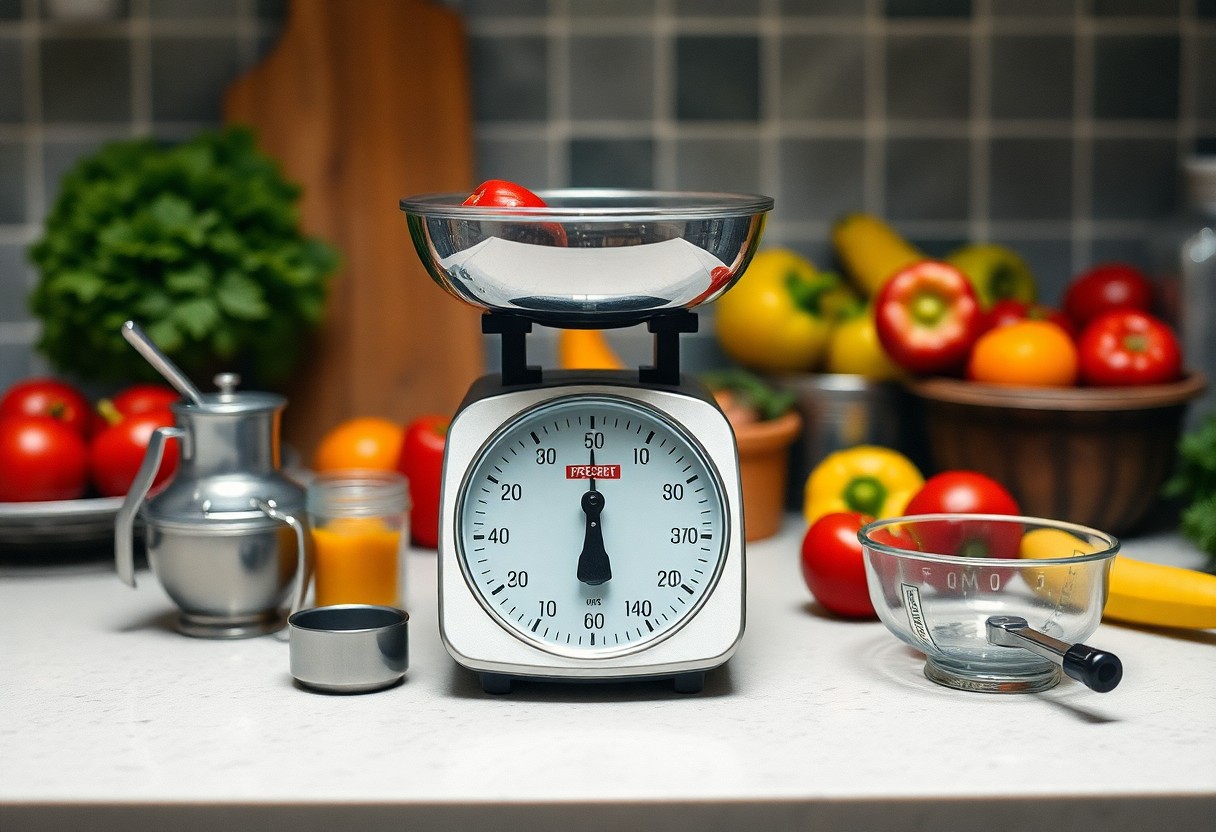Precision in cooking and baking can make all the difference in your culinary creations, but your kitchen scale might be hiding some important details. You may not realize that factors such as calibration, unit conversion, and even scale placement can significantly impact your measurements.
By understanding these hidden aspects, you can enhance your accuracy and improve your overall results in the kitchen.
In this post, you’ll learn how to identify and correct these common pitfalls, ensuring your scale provides the reliable measurements you need for perfect dishes every time.

Key Takeaways:
- Your kitchen scale may not provide consistent measurements if it’s improperly calibrated, so regularly check and adjust it to ensure accuracy.
- Factors such as temperature, humidity, and the type of container used can affect weight readings; consider using a tare function for better precision.
- Different ingredients have varying densities, so always consult specific conversion charts for accurate measurements when switching between different substances.
The Scale’s Secret Limitations
Your kitchen scale may not divulge all the intricacies of accurate measurement, presenting a facade of precision while hiding its limitations. Despite offering a straightforward readout, scales can be misleading if you don’t consider factors like calibration, weight distribution, and environmental conditions.
A scale’s accuracy can vary depending on its design and the ranges it’s best suited for, meaning that your results may not be as precise as you believe.
The Role of Surface Area in Weight Distribution
Surface area significantly influences how weight is distributed on your scale, affecting accuracy and precision. Different shapes or forms of an ingredient can lead to varying contact points and pressure distributions on the scale, influencing the weight reading.
For instance, a heap of flour versus a flat scoop will produce different readings due to the changes in how the weight is distributed during measurement.
When ingredients have different surface areas, such as a block of butter versus softened butter, the weight experiences varying levels of pressure on the scale. The increased surface area of softened butter can lead to a slightly lower reading compared to a solid form.
Furthermore, calibrating the scale to accommodate these differences is vital. If you consistently measure ingredients with irregular shapes or packed elements, consider using containers or levels that promote even distribution to improve accuracy.
Calibration Conundrums: Importance and Solutions
Your kitchen scale’s reliability hinges on its calibration, which can significantly affect measurement accuracy. Many users overlook this key element, assuming their scale is always ready for action. Without regular calibration, even the best scales can drift from true zero or provide inconsistent results, leading to discrepancies in your recipes that could compromise flavor or texture.
The Frequency of Calibration: How Often Is Enough?
Calibration frequency largely depends on how often you use your scale and the conditions it’s exposed to. For scales in daily use, checking calibration every month is advisable. If your scale experiences significant changes in temperature, humidity, or if you’ve moved it, a calibration check is warranted each time.
DIY Calibration: Techniques for Accuracy
Calibrating your kitchen scale at home doesn’t require advanced tools. You can use standardized weights or common items with known weights, such as five-pound bags of flour or canned goods. Start by placing the item on the scale, noting the reading, and adjusting as necessary according to the referenced weight.
For a more refined DIY calibration, consider using multiple standardized weights to gauge accuracy at various increments. You can check 1, 5, and 10 pounds, for example. Creating a simple test log will help you track and identify any drift over time. Adjusting your scale using this method can enhance your culinary precision, making every dish a success.
Environmental Influences on Your Readings
Your kitchen scale’s readings can be swayed by various environmental factors, which may lead to inconsistent measurements. Ignoring these influences could result in mishaps that affect your cooking and baking outcomes. Pay attention to your surroundings to ensure that your measurements are as precise as possible.
Temperature Fluctuations: Impact on Materials
Temperature and Material Behavior
| Heating | Materials such as plastics can warp, leading to inaccurate weight measurements. |
| Cooling | Metals may contract, affecting calibration and weight distribution on your scale. |
Humidity Effects: Why Moisture Matters
High humidity can introduce moisture into your ingredients, therefore skewing weight. Ingredients like flour absorb moisture from the air, causing significant variations in mass. On the contrary, overly dry conditions might lead to ingredient shrinkage, further complicating measurements.
This variation is particularly evident when measuring dry ingredients. For instance, flour stored in a humid environment can absorb water, adding extra grams to its weight. In contrast, if you’re in a dry area, flour might weigh less due to moisture loss.
To maintain consistency, use airtight containers for storage and consider weighing ingredients in a controlled environment. These practices help mitigate the influence of humidity, giving you better control over your measurements.
Enhancing Precision: Best Practices for Use
To achieve the highest accuracy with your kitchen scale, adopting best practices is vital. Simple adjustments in your approach can yield significant improvements in precision, ensuring that every recipe is spot-on. From proper placement to thoughtful container selection, small changes can make a big difference in your measuring game.
Placement Matters: Finding the Ideal Surface
Positioning your kitchen scale on a stable, flat surface is fundamental to obtaining precise measurements. Uneven countertops or soft materials can lead to incorrect readings. Aim for solid surfaces like a heavy wooden table or a granite countertop to eliminate variable influences while you weigh ingredients.
Container Choices: Optimizing for Weight
Choosing the right container can greatly impact your scale’s accuracy. Lightweight materials such as plastic can fluctuate under weight, while sturdy glass or metal options provide a steadier base for measurements.
Selecting a container designed for your specific tasks, like mixing bowls for dry goods or liquid measuring cups for fluids, simplifies the process and enhances precision.
Utilizing a container that closely matches the weight of the ingredients you’re measuring can help limit discrepancies. For instance, using a heavy ceramic bowl for dense ingredients will create a more stable reading than a flimsy plastic one.
Additionally, tare functionalities on most scales allow you to subtract the weight of the container, ensuring you’re only measuring the ingredient’s weight. This not only improves accuracy but also saves time on conversions, making your baking and cooking experiences more efficient.

Advanced Techniques for Cooking Professionals
For culinary experts striving for perfection, mastering precision techniques is non-negotiable. By embracing advanced methodologies, you elevate your culinary creations to art. Here are some pivotal techniques:
- Utilizing tare functionality for ingredient layering
- Incorporating temperature control for ingredient accuracy
- Employing weight-to-volume conversions for recipe scaling
- Leveraging fractions for exact ingredient measurements
- Regular maintenance checks to ensure consistent performance
To address any inconsistency in your kitchen scale, refer to this insightful guide on How to fix an inaccurate scale.
Key Considerations for Multi-Scale Systems
| Consideration | Details |
| Capacity | Choose scales based on volume requirements, from small ingredients to bulk items. |
| Type | Opt for both digital and analog scales for varied uses. |
| Precision | Ensure different scales offer the same accuracy across the board. |
Multi-Scale Systems: When One Just Isn’t Enough
Utilizing multiple scales can streamline your workflow in a busy kitchen. Different scales cater to specific measurements—large quantities might warrant a robust, heavy-duty scale, while fine herbs could benefit from a more delicate, precise option. This versatility allows you to maintain efficiency and precision while managing numerous dishes simultaneously.
Digital Innovations: Smart Scales and Their Benefits
Smart scales represent a leap into the future, offering connectivity and innovative features that enhance cooking precision. You can easily track ingredient usage over time, link to recipe apps for automatic conversions, and even share your culinary successes online. These models often incorporate built-in databases, ensuring you achieve consistency every time.
Opting for a smart scale also means access to features like Bluetooth connectivity and integration with kitchen apps. Not only do these functionalities allow for real-time tracking of your recipe’s weight, but they also enable you to enjoy step-by-step guidance while cooking. This integration saves time and reduces errors, fulfilling the need for accuracy in a bustling professional kitchen.
Conclusion
Following this guide, you now understand that your kitchen scale might not provide all the precision you need for successful cooking and baking. By considering factors like tare weight, calibration, and the type of measurement you use, you can enhance your accuracy significantly.
Implementing these adjustments can elevate your culinary creations, ensuring they turn out just as intended every time. Embrace these tips to refine your technique and achieve consistent results in your kitchen endeavors.
Q: Why is my kitchen scale showing different weights for the same item?
A: Variability in weight readings can occur due to several factors. First, ensure your scale is on a flat, stable surface. An uneven surface can lead to inaccurate measurements. Additionally, some scales automatically adjust based on the weight of the container, which can cause inconsistent readings if not zeroed properly.
Always use the tare function to reset the scale to zero with the container before adding your ingredient. Also, consider the scale’s calibration. If it hasn’t been calibrated recently, it may provide incorrect weights. Regular checks and calibrating your scale according to the manufacturer’s instructions can help improve accuracy.
Q: How can humidity affect my kitchen scale measurements?
A: Humidity can impact the weight of certain ingredients, particularly dry goods like flour and sugar. When exposed to moisture in the air, these ingredients can absorb water, leading to an increase in weight that doesn’t reflect their true dried state. To account for this, try to store ingredients in airtight containers to minimize moisture exposure.
Moreover, for precise measurements, it may be beneficial to weigh ingredients shortly after opening or in a controlled environment. If you frequently deal with humidity-related issues, consider using a dehumidifier in your kitchen or weighing ingredients in a less humid area of your home.
Q: What should I do if my kitchen scale is consistently off by a certain amount?
A: If you’ve noticed that your kitchen scale is consistently displaying weights that are either above or below what you expect, it’s possible that it needs calibration. Most digital scales come with a calibration feature; check the user manual for instructions specific to your model. Calibration typically involves placing known weights on the scale to adjust its readings.
If calibration does not resolve the issue, consider replacing the batteries, as weak batteries can lead to inaccurate readings. If issues persist, it may indicate that the scale is damaged or nearing the end of its lifespan, and investing in a new scale might be the best solution for maintaining precision in your cooking and baking.

Alden Pierce is a passionate home cook and the creator of Cooking Again. He loves sharing easy recipes, practical cooking tips, and honest kitchen gear reviews to help others enjoy cooking with confidence and creativity. When he’s not in the kitchen, Alden enjoys exploring new cuisines and finding inspiration in everyday meals.
